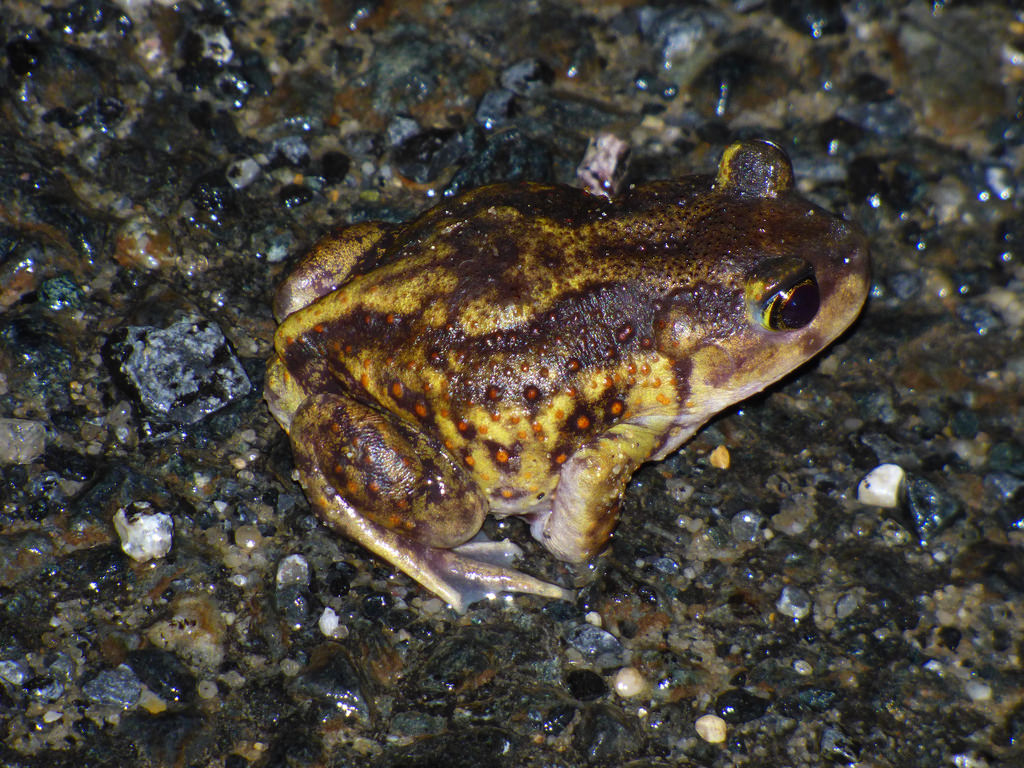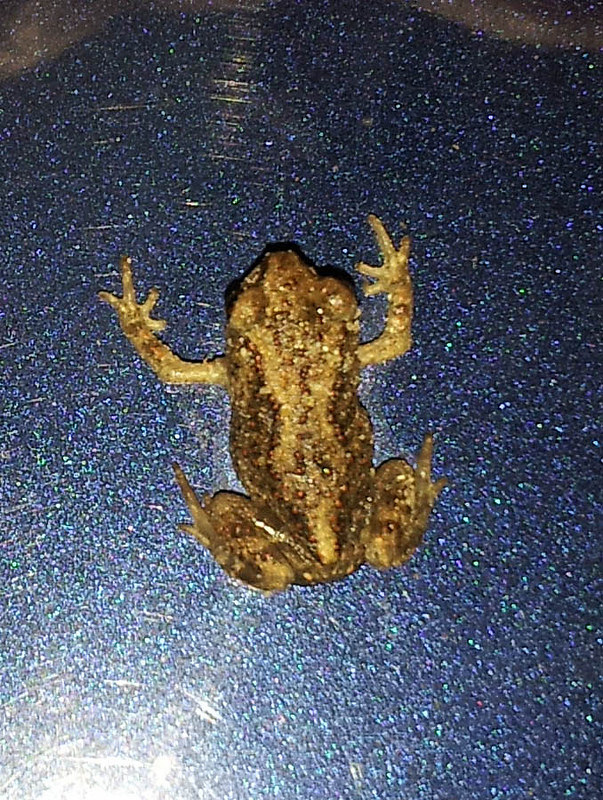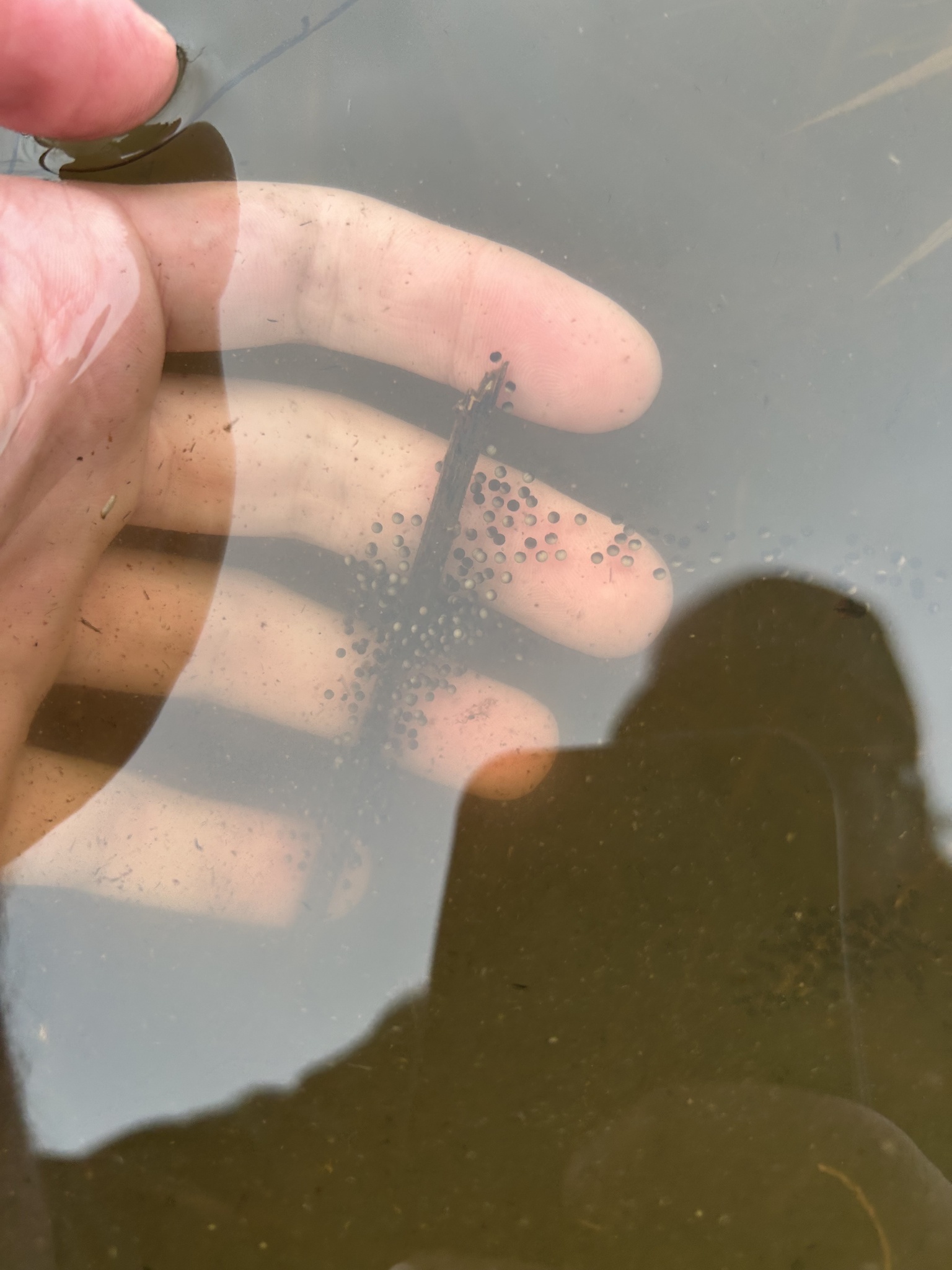Map Snapshot



















195 Records
Eastern Spadefoots in Caroline Co., Maryland (5/19/2018). - Mark Schilling.
Eastern Spadefoot in Charles Co., Maryland (6/11/2021). (c) Tim Emhoff, some rights reserved (CC BY-NC). - Tim Emhoff via iNaturalist.
Eastern Spadefoot calling in Talbot Co., Maryland (4/29/2023). - Mark Schilling.
Eastern Spadefoot in Kent Co., Maryland (Date obscured). (c) Cole Tiemann, some rights reserved (CC BY-NC). - Cole Tiemann via iNaturalist.
Status
Eastern Spadefoot (Scaphiopus holbrookii) is the only spadefoot species found in Maryland (and anywhere east of the Mississippi). While often called "spadefoot toads," spadefoots (family Scaphiopodidae) are actually not closely related to the true toads of the family Bufonidae. They are strangely-shaped, with an elongated spade-shaped structure on the hind foot, large eyes with vertical pupils, and no parotoid glands. This species is highly fossorial (active primarily underground), and outside of the breeding season, they are usually seldom encountered. Spadefoots are associated with loose, sandy soil, which is easy to burrow into, and as a result, they are most common on the coastal plain. After heavy rains in spring or summer, spadefoots emerge from underground and migrate to breeding sites in shallow wetlands and pools. The entire breeding cycle may occur on only a few nights a year at a given locality (Conant & Collins, 1998; Maryland DNR site; Virginia Herpetological Society site).
Seasonality Snapshot
Source: Wikipedia
| Scaphiopus holbrookii | |
|---|---|

| |
| Scientific classification | |
| Domain: | Eukaryota |
| Kingdom: | Animalia |
| Phylum: | Chordata |
| Class: | Amphibia |
| Order: | Anura |
| Family: | Scaphiopodidae |
| Genus: | Scaphiopus |
| Species: | S. holbrookii
|
| Binomial name | |
| Scaphiopus holbrookii (Harlan, 1835)
| |
| Synonyms | |
Scaphiopus holbrookii, commonly known as the eastern spadefoot, is a species of American spadefoot toad (family Scaphiopodidae) endemic to the eastern United States. It is not considered a true toad, with Bufonidae being the family of "true toads".[2][1][3][4]
Taxonomy
[edit]The epithet, holbrookii, is in honor of John Edwards Holbrook, American herpetologist.[5] A similar species is Hurter's spadefoot toad, which was once considered a subspecies of S. holbrookii.[6]
Unlike some other spadefoot toad species, such as Spea multiplicata (the Mexican or desert spadefoot) or Spea bombifrons (the plains spadefoot toad), Scaphiopus holbrookii never naturally develop cannibal tadpoles through phenotypic plasticity. Researchers at the University of North Carolina at Chapel Hill believe this is because the eastern spadefoot is most representative of the first spadefoot toads to evolve.[7][8]
Distribution and habitat
[edit]It is mostly found in the southeastern United States, except for mountainous areas, and is also found northward along the Atlantic coast into southern New England, where it is considered rare. It is found in inland states such as Pennsylvania and New York, but only as far westward as the Appalachian Mountains, and the Hudson River Valley in New York.[9] Absent from the Appalachians, but occurs west of them in Tennessee, Kentucky, and southern reaches Illinois, Indiana, and Missouri.[10] They are endangered Connecticut where it is found that they only have one viable population in the state.[11]
Prefers habitats with loose, commonly sandy, soils for burrowing[12] like Longleaf pine forests with open understories from intermittent natural burn events.[13] Most abundant in forests with little leaf litter and sparse shrubs.[4] Research has looked into the habitat selection of the species and has found that it tends to hover around upland areas. It has shown preference for being close to deciduous shrub edges, low-growing pitch pine branches, and reindeer lichen. This environment provides an easy place to burrow, a dense prey biomass, and protection from predators.[14]
Description
[edit]
The average length of an adult eastern spadefoot is 44–57 mm (1+3⁄4–2+1⁄4 in). It is brownish in color, with two yellowish stripes on its back. These stripes, which begin on the upper eyelids, may diverge or converge, resulting in a pattern resembling a lyre or an hourglass. Some specimens may be very dark, with less distinct markings.[9] The skin is normally smoother and moister than other toads.[15] Their skin is also sparsely peppered with little warts across the entirety of the body.[16] The eastern spadefoot belongs in one of only four groups of burrowing terrestrial anurans.[17] It has one spur on each of its back feet for burrowing.[6] The spur is generally three times longer than the other toes.[18]
Behavior
[edit]Scaphiopus holbrookii spends almost all of its life deep underground; emerging only to breed or feed. It remains in a type of hibernation almost all its life. It burrows in a spiral.[19]
One study used passive integrated transponders (PIT tags) to monitor emergence from burrows. The study found that S. holbrookii emerge about 43% of the nights they were monitored. They are much more likely to emerge if they had emerged the night prior as well. They also tended to emerge more frequently from their burrows on nights that were warmer and more humid, or the night after/during rain. Other than the emergence after rain and during breeding season, these animals do not have a specific pattern to their burrow emergence; the movements seem to be very random. [20]
Diet & Predation
[edit]Although Scaphiopus holbrookii is both diurnal and nocturnal, most foraging for food sources, consisting of small invertebrates such as termites, insects, arachnids, worms, ants, beetles, and grasshoppers is completed during the day.[21] Some species will completely leave to burrow in search of prey; however, a common tactic for the eastern spadefoot is to simply sit at the opening of the burrow and wait for prey to pass by. [22]
Being burrowing species, spadefoot toads avoid a large amount of predation at the surface, but when exposed during foraging or breeding, they are preyed upon by mammals such as opossums and racoons, birds, and snakes.[23]
Reproduction
[edit]S. holbrookii requires fish-free ephemeral ponds for breeding but occupies other habitats such as longleaf pine and wiregrass ecosystems when not breeding.[4] They use inguinal amplexus while mating.[4] Eastern spadefoot toads are explosive breeders during sufficient rainfall and eggs are usually attached to submerged vegetation. [24] Hatching and development rates are highly variable, mediated by ambient air and water temperatures, hatching as quickly as under 12 hours, slowly as over 7 days, and develop into adults in 14-60 days.[25] The eastern spadefoot toad can breed in almost any month of the year.[19] Even though they can breed during any month they do always breed at night to lessen the threat of predation.[26] Due to the explosive breeding, once eggs hatch often food becomes limited from the large populations of tadpoles. S. holbrookii tadpoles are known to be omnivorous. In the event of food shortages some larvae adapt aggressive feeding habits consuming large animal prey including other S. holbrookii tadpoles. These cannibalistic morphs develop at a heightened rate and become much larger tadpoles in comparison to the non-cannibal morphs.[27]
Conservation status
[edit]While not listed as an endangered species by the U.S. federal government, S. holbrookii is considered "threatened" in Massachusetts [28] and Connecticut.[29] In that state and in 13 others, it is listed as a "Species of Greatest Conservation Need".[30]
References
[edit]- ^ a b IUCN SSC Amphibian Specialist Group (2022). "Scaphiopus holbrookii". IUCN Red List of Threatened Species. 2022: e.T59042A196336701. doi:10.2305/IUCN.UK.2022-1.RLTS.T59042A196336701.en. Retrieved 12 May 2023.
- ^ Moran, Katherine, and Charles E. Button. “A GIS model for identifying Eastern spadefoot toad (scaphiopus holbrookii) habitat in Eastern Connecticut.” Applied Geography, vol. 31, no. 3, July 2011, pp. 980–989, https://doi.org/10.1016/j.apgeog.2011.01.004.
- ^ Frost, Darrel R. (2015). "Scaphiopus holbrookii (Harlan, 1835)". Amphibian Species of the World: an Online Reference. Version 6.0. American Museum of Natural History. Retrieved 4 January 2016.
- ^ a b c d Greenberg, Cathryn H.; Tanner, George W. (2004-12-01). "Breeding Pond Selection and Movement Patterns by Eastern Spadefoot Toads (Scaphiopus holbrookii) in Relation to Weather and Edaphic Conditions". Journal of Herpetology. 38 (4): 569–577. doi:10.1670/5-04A. ISSN 0022-1511. S2CID 16533250.
- ^ Bo Beolens; Michael Watkins; Michael Grayson (22 April 2013). The Eponym Dictionary of Amphibians. Pelagic Publishing. p. 96. ISBN 978-1-907807-44-2.
- ^ a b "Eastern Spadefoot Toad". eNature. Retrieved 28 March 2016.
- ^ Pennisi, Elizabeth (28 November 2018). "Cannibalistic tadpoles and matricidal worms point to a powerful new helper for evolution". ScienceMag.org. American Association for the Advancement of Science. Retrieved 10 September 2020.
- ^ Levis, N.A.; Isdaner, A.J.; Pfennig, D.W. (2018). "Morphological novelty emerges from pre-existing phenotypic plasticity". Nature Ecology & Evolution. 2 (8): 1289–1297. doi:10.1038/s41559-018-0601-8. PMID 29988161. S2CID 256708228.
- ^ a b Conant, Roger. 1975. A Field Guide to Reptiles and Amphibians of Eastern and Central North America. Second Edition. Houghton Mifflin. Boston. 429 pp. ISBN 0-395-19977-8 (pbk.) (Scaphiopus holbrooki holbrooki, p. 299 + Plate 44 + Map 253.)
- ^ Wasserman, A. O. (1968). Scaphiopus holbrookii. Catalogue of American Amphibians and Reptiles (CAAR)
- ^ Moran, Katherine, and Charles E. Button. “A GIS model for identifying Eastern spadefoot toad (scaphiopus holbrookii) habitat in Eastern Connecticut.” Applied Geography, vol. 31, no. 3, July 2011, pp. 980–989, https://doi.org/10.1016/j.apgeog.2011.01.004.
- ^ Johnson, K. A. (2003). Abiotic factors influencing the breeding, movement, and foraging of the eastern spadefoot (scaphiopus holbrookii) in west virginia
- ^ Greenberg CH, Tanner GW (2004) Breeding Pond Selection and Movement Patterns by Eastern Spadefoot Toads (Scaphiopus holbrookii) in Relation to Weather and Edaphic Conditions. Journal of Herpetology 38:569–577. https://doi.org/10.1670/5-04A
- ^ Timm, Brad C., et al. “Upland Movement Patterns and Habitat Selection of Adult Eastern Spadefoots (Scaphiopus holbrookii) at Cape Cod National Seashore.” Journal of Herpetology, vol. 48, no. 1, 2014, pp. 84–97. doi:10.1670/12-201
- ^ Overduijn, K. (n.d.). Eastern spadefoot toad (scaphiopus holbrookii). Species Profile: Eastern Spadefoot Toad (Scaphiopus holbrookii) | SREL Herpetology. Retrieved 11 February 2023.[1]
- ^ Moran, Katherine, and Charles E. Button. “A GIS model for identifying Eastern spadefoot toad (scaphiopus holbrookii) habitat in Eastern Connecticut.” Applied Geography, vol. 31, no. 3, July 2011, pp. 980–989, https://doi.org/10.1016/j.apgeog.2011.01.004.
- ^ https://palaeo-electronica.org/content/content/2015/1299-neoichnology-of-toads. Johnson, L. M., & Hembree, D. I. (2015). Neoichnology of the eastern spadefoot toad, Scaphiopus holbrookii (Anura: Scaphiopodidae): criteria for recognizing anuran burrows in the fossil record. Palaeontologia Electronica, 18(2), 1-29.
- ^ https://repositories.lib.utexas.edu/bitstream/handle/2152/45000/0070_Scaphiopus_holbrookii.pdf?sequence=1 Wasserman, A. O. (1968). Scaphiopus holbrookii. Catalogue of American Amphibians and Reptiles (CAAR). Retrieved February 11, 2023
- ^ a b Erickson, M.R., Scott, D.E., Jones, K.L. et al.; Development and characterization of ten microsatellite loci for the eastern spadefoot toad, Scaphiopus holbrookii. Conservation Genetics Resources 2, 143–145 (2010). doi:10.1007/s12686-010-9198-1
- ^ Ryan, Calhoun, A. J. K., Timm, B. C., & Zydlewski, J. D. (2015). Monitoring Eastern Spadefoot (Scaphiopus holbrookii) Response to Weather with the Use of a Passive Integrated Transponder (PIT) System. Journal of Herpetology, 49(2), 257–263. doi:10.1670/12-230
- ^ Whitaker, John O.; Rubin, David; Munsee, Jack R. (1977). "Observations on Food Habits of Four Species of Spadefoot Toads, Genus Scaphiopus". Herpetologica. 33 (4): 468–475. ISSN 0018-0831.
- ^ Smith, Tristan. "Scaphiopus holbrookii (Eastern Spadefoot)". Animal Diversity Web. Retrieved 29 April 2022.
- ^ Johnson, K. A. (2003). Abiotic factors influencing the breeding, movement, and foraging of the eastern spadefoot (scaphiopus holbrookii) in west virginia
- ^ "Virginia Herpetological Society". www.virginiaherpetologicalsociety.com. Retrieved 2022-04-05.
- ^ Richmond ND (1947) Life History of Scaphiopus Holbrookii Holbrookii (Harlan). Part I: Larval Development and Behavior. Ecology 28:53–67. https://doi.org/10.2307/1932918
- ^ Moran, Katherine, and Charles E. Button. “A GIS model for identifying Eastern spadefoot toad (scaphiopus holbrookii) habitat in Eastern Connecticut.” Applied Geography, vol. 31, no. 3, July 2011, pp. 980–989, https://doi.org/10.1016/j.apgeog.2011.01.004.
- ^ "Meet the larval amphibians that morph to become cannibals". Animals. 2019-06-26. Archived from the original on March 2, 2021. Retrieved 2022-04-06.
- ^ "Eastern Spadefoot Scaphiopus holbrookii" (pdf). List of Endangered, Threatened, and Special Concern species. Massachusetts Division of Fisheries & Wildlife. 2015. Retrieved 5 May 2020.
- ^ Moran, Katherine, and Charles E. Button. "A GIS model for identifying eastern spadefoot toad (Scaphiopus holbrookii) habitat in eastern Connecticut." Applied Geography 31.3 (2011): 980-989. doi:10.1016/j.apgeog.2011.01.004
- ^ "USGS map of S. holbrookii by state wildlife action plan (SWAP)" (dynamic map). USGS Core Science Analytics, Synthesis, and Libraries. USGS. Retrieved 5 May 2020.




























